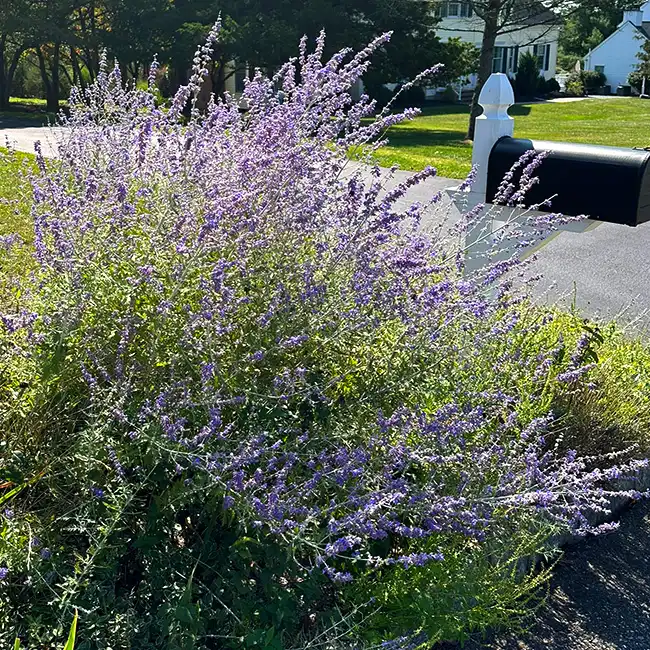
Russian sage (Perovskia atriplicifolia) is a beloved perennial in many gardens, known for its tall, airy spikes of lavender-blue flowers and silvery-gray foliage. This drought-tolerant plant provides not only a splash of color but also serves as a reliable late-season bloomer, extending the beauty of your garden well into fall. It is also a valuable plant for attracting pollinators like bees and butterflies.
One cautionary note is that it tends to spread and can dominate a garden bed. It propagates through underground roots, and I have discovered new plants emerging as far as ten feet away. Then, if that plant grows, it will send out tendrils.
Pollinator Attractor and Late-Season Bloomer
One of the standout qualities of Russian sage is its ability to attract pollinators. The vibrant flowers, which bloom from mid-summer through fall, are irresistible to bees, butterflies, and even hummingbirds. This makes it an excellent choice for pollinator gardens and for gardeners looking to support local ecosystems.
Additionally, Russian sage blooms later in the growing season, offering a burst of color when many other plants have faded. Its long blooming period provides continuous nectar for pollinators, particularly during the late summer when food sources can become scarce.
As a perennial, Russian sage returns year after year with little fuss, making it a low-maintenance option for gardeners. Its hardy nature allows it to thrive in USDA zones 4 to 9, and it is particularly prized for its ability to withstand drought once established. The silvery-gray foliage remains attractive even when the plant is not in bloom, adding texture to your garden throughout the growing season.
Growing Tips for Russian Sage
To make the most of Russian sage in your garden, follow these simple growing tips:
- Sunlight Requirements: Plant Russian sage in full sun to encourage the best flowering and strong growth. It needs at least 6 to 8 hours of sunlight daily.
- Soil Conditions: Russian sage thrives in well-drained soil and can tolerate poor, rocky, or sandy soils. Avoid heavy, clay-like soils, as these can cause the plant to become waterlogged.
- Watering: While Russian sage is drought-tolerant once established, it will benefit from regular watering during its first growing season. After that, water sparingly—overwatering can lead to root rot.
- Spacing and Growth: Give each plant plenty of space, at least 2 to 3 feet apart. Russian sage grows in bushy clumps and can reach heights of 3 to 5 feet, with a spread of about 2 to 3 feet.
- Pruning and Maintenance: In early spring, cut back the stems to about 12 inches to encourage healthy new growth. Removing dead or damaged stems also keeps the plant looking tidy.
- Fertilization: Russian sage generally doesn’t require much fertilization. A light application of compost in the spring is usually sufficient.
- Companion Plants: Pair Russian sage with plants like coneflowers, sedum, and ornamental grasses to create a visually pleasing garden that attracts even more pollinators.
- Winter Care: Russian sage is hardy but leaving the plant's stems and foliage intact over winter can provide added protection from cold weather. In the spring, trim away any dead material.
Russian sage is an ideal addition to any garden, particularly for gardeners looking to attract pollinators and enjoy vibrant color well into the fall. With minimal care requirements and great drought tolerance, it’s a perfect choice for a low-maintenance, high-impact garden.

